See likes given/taken
| Post info | No. of Likes |
|---|---|
|
Re: What's Going On In Your Unreal World?
I'm back to URW for the past couple of weeks, after having taken a hiatus of more than a year. I'm currently weighing up moving my home base, even after having built a small cabin (my smoking house). I'm currently on a four tile island, with my home site in one corner and a farming site on another corner, both with ice-free access year round, while also not being accessible over ice from the mainland. That's my preferred kind of home site. There's another site half-a-day away which is three small islands with ice-free access next to each other, and I may move there. Ideally I'd have two one-tile islands like that, one for my home site and one for my fields (smaller islands attract fewer animal visitors, and I don't want animal visitors to my fields), but that has proven elusive. Maybe I'll do some more scouting; there is still time before I need to commit to one home site for winter. Or I could try something I've never done, not only play a nomad over the winter but a nomad travelling by watercraft, which is likely to be really challenging but I'm not sure if it would be much fun (long-distance travelling by watercraft when most water is frozen over can be very tedious). The trap fence I set up for the Advanced Adventures course is rather unsuccessful, with only two elk caught after about a month in action, and one of those was only caught after I chased an elk into the fence (a very successful strategy I highly recommend, and closer to how trap-fences were and are actually used). After the changes to animal spawning ~2 years ago, trap fences need more thought, and I rushed into this one even though I had misgivings about this site I built it anyway. That'll teach me. My other possible home-site is further away from this trap fence, so I'll probably just break it down (or just trigger the traps and abandon it) and maybe not build a new one. My main meat source is seal, and I get enough of them to not need any more meat. I've already stopped setting out my nets except when I specifically want fresh food. I must admit one of the factors keeping me in my current home site is the fact that it is in an area called 'Sword Strait', and that's just cool 
February 14, 2019, 02:05:14 PM |
1 |
|
Re: What's Going On In Your Unreal World?
As a new player, new to urw that is, I made some rookie mistakes. First was not reading anything much before I started. Just seeing permadeath and wilderness survival was enough to hook me. I started as an Islander as they sounded interesting and fit my mood at the time, and I started in the home culture as that sounds as if it might make life easier to learn. I started with the Unreal World as that sounded most like a tutorial. I found what looked like a good site to start, on the banks of a lake with lots of conifer trees around and some heathland nearby with other trees. I quickly learnt to collect firewood, built a shelter and learnt to fish. I tried to do anything I could using skills lists, I made a cup and bowl and some planks and as my fishing skill increased I built a cellar for food storage, nothing I made was very good quality as I only had poor tools to use and was getting fed up with eating fish so I spent a few days exploring where I lived, it was moving into summer and ice was melting when I found I had chosen to live on a small island, the lake I had been using as a water source was in fact sea water, the only other fauna on the island was a grouse who could spot me hiding from 20 squares away, even the javelins I had made fell short if I could throw them straight. I did spot a village at the limit of my sight once, on the far side of an ever widening sea, but until I find a way to make ropes I might be stuck here until winter, eating fish and drinking sea water. April 14, 2019, 10:50:08 AM |
1 |
|
Tracks covered and decayed by snowfall and rain
I've had a simple roadmap for the next patch update with a simple goal of "fix a dozen things, add half a dozen new things". The fixes are soon done, and new features are being worked on. One thing to mention is an addition of snowfall and rain now covering and decaying tracks. Track decay rate naturally depends on amount of snowfall or rain, and also the age of the tracks. Severe snowfall may cover fresh tracks in a hour so the weather now gets to play a greater role in tracking. Few more fixes, few more additions to go. And then getting to build a new update. And as we can see and imagine from this example one single addition can easily include half a dozen side factors and bring up dozens of new situations to our adventuring characters. February 19, 2020, 06:40:22 PM |
1 |
|
Re: There is a really huge difference between build 3.62 and build 3.63?
Another factor would be mod support. Mod support for the BAC, my own and a large commonly used mod, is to the current game version 3.63 I believe somewhere in the thread is the last 3.62 version in what ever state it was at that time. Other modders would likewise be fixing bugs and things for the current version. In some cases, possibly 3.62 to 3.63, the newer mod version might work on an older game but no garauntees. April 03, 2021, 02:59:51 AM |
1 |
|
Sneak preview of textilecraft system with screenshots and additional insight
Time for a little sneak preview with our textilecraft test character Kuitu Kaumolainen. Some of the stuff mentioned here has been mentioned before, but a summary about textilecraft is in place now. With some sdditional insight and sidetracking included. So, the biggest single addition to the upcoming version is featuring mechanics to extract fibres from certain plants and process them into yarn. For this, a new TEXTILECRAFT skill was created, and lots of spin-off features regarding fibre processing and cordage also followed. Fibres can be extracted from nettle, hemp and flax - which has been added as a new cultivated plant. Let's start from there ... Flax Flax is an old cultivated textile plant, but in Iron-Age Finland it wasn't even as commonly grown as hemp. One reason for this is that flax doesn't survive in the very north so in the game it's grown only by certain cultures south of Kaumo. As a curiosity, the finnish word for flax ('pellava') originally meant the nettle plant ('nokkonen') which speaks about importance of this age-old wild source of fibre. But nevertheless, flax is in the game now and it can be grown, harvested and processed for fibre. 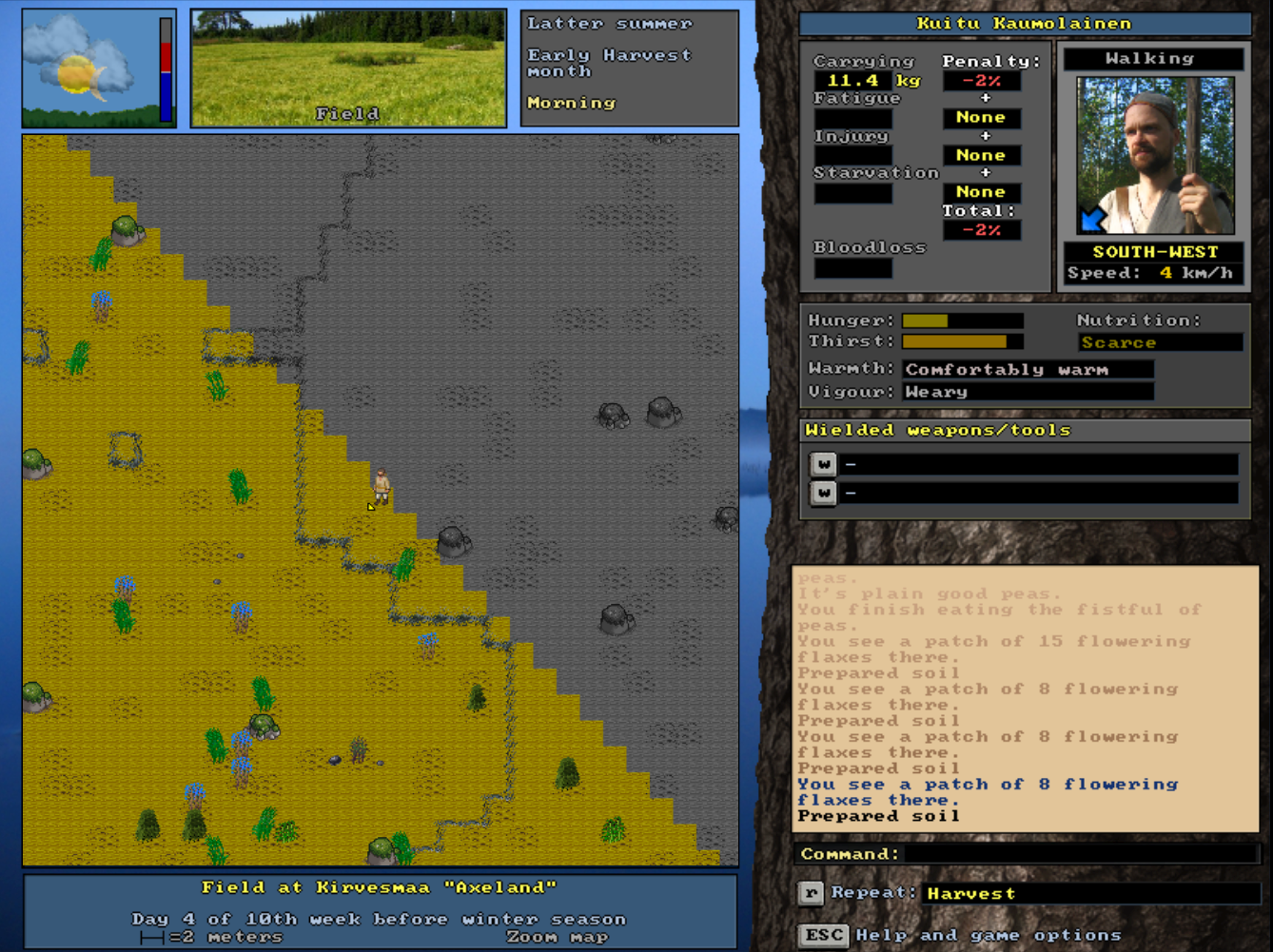 Kuitu Kaumolainen has found his way to Kiesse, a region where flax is grown. At Kaumo where he's from they only produce nettle or hemp fibres. Blue flowering flax is easily spotted from the field, and it could be harvested for fibre already. Textilecraft options Processing plant fibres into yarn involves several stages of work, and it's all done by using your TEXTILECRAFT skill. Character's expertise in textilecraft affects to required working times and the amount of usable fibre or yarn produced. After the plants are harvested the fibres must be then separated from the plant's stalks. This process is called "retting", and it is done by soaking the plants in the water for several days. Sufficient soaking time depends on the water temperature, with the warmer being faster. 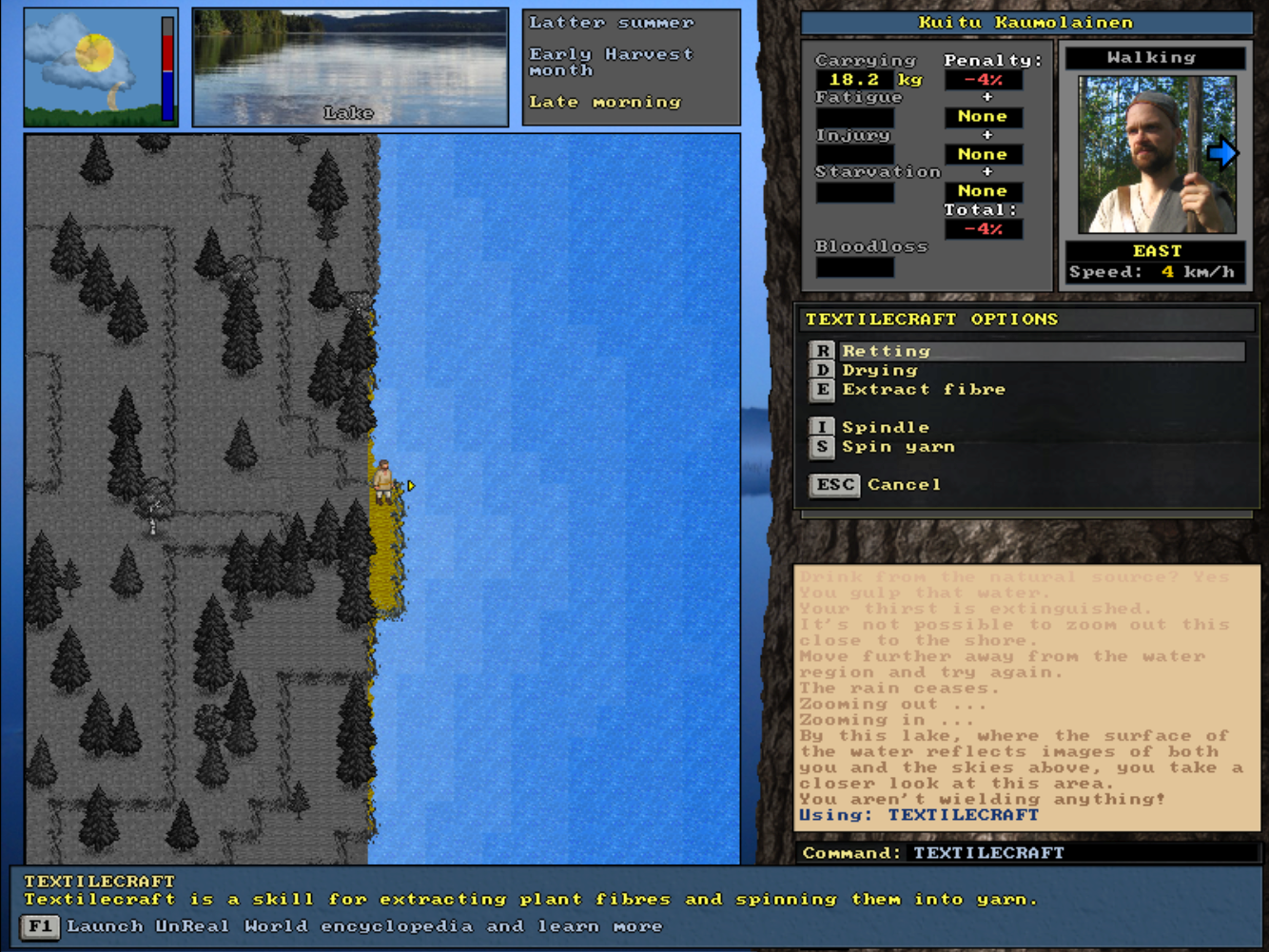 Kuitu Kaumolainen harvested 100 flaxes and headed by the lake to start retting the stalks. Here you can see all the textilecraft options to proceed with fibre extracting and spinning them into yarn. Extracting fibres is hard work It took two weeks for Kuitu's flax to soak properly. After that it took one more week to dry them. And only then Kuitu can start extracting the actual fibre from the stalks. Extracting fibres is done by breaking the dried retted stalks so that the woody core shatters and falls away leaving the loose fibres free. The stalks are beated for example with a club on a solid working surface. Extracting fibres is hard work and commonly carried out with several people working together. Traditionally there has been a custom to arrange specific work parties for processing fibres of each village together with the neighbouring people. And in the game your companions can actually help you with the task. Obtained bundles of fibre are then scraped free from remaining coarse parts. Traditionally special tools were used, but it can be also done by rubbing and whacking the bundles against a hard surface, or with tools at hand. 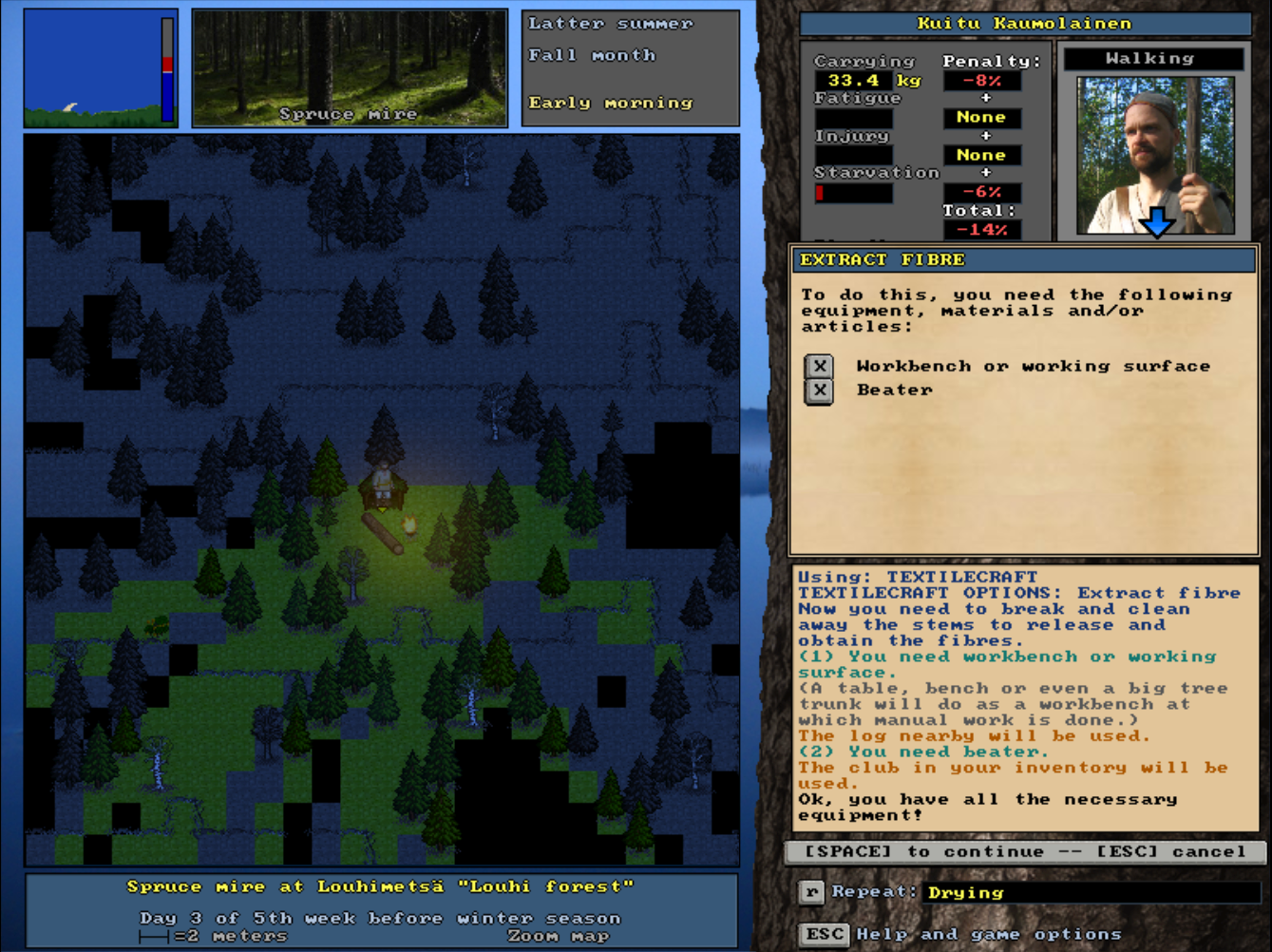 Kuitu starts extracting fibres from the dried retted flax stalks at his shelter. He is about to beat the stalks with a club on top of a log. These dried retted stalks could have been also stored for future and the fibre extracted when there's time and need for that. Spinning yarn It took lees than half an hour to extract the fibres from his 100 flax stalks and Kuitu got 16 bundles of flax fibre. Fibres can be then spun into yarn either by hand, which is slower, or using a spindle. Spindle is also a new craftable item, and very easy to make. So Kuitu crafts a spindle and starts spinning. He decides to go for full length yarn. When starting spinning it is possible to choose how long yarn you wish to spin on one go. 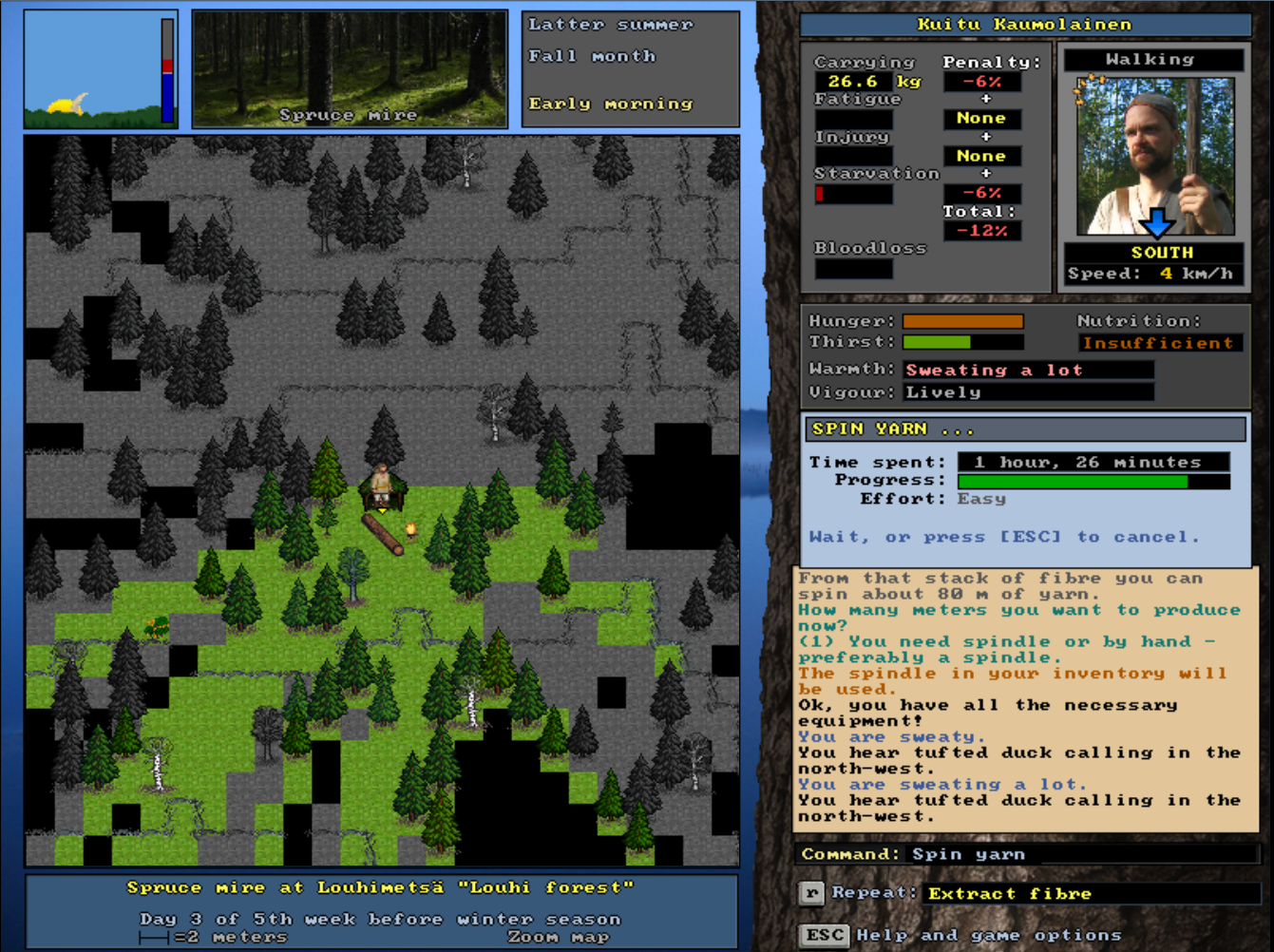 Kuitu manages to spin 80 meters of linen yarn in less than two hours. It could be then used in crafting of different items such as loop snares, arrows - or fishing rods. Nettle specialities In the next version it will be also possible to craft fishing rods, and hooks out of wood or bone. And a working fishing rod naturally needs a line too. Now Kuitu has his linen yarn which could be used as line, but the whole process of extracting flax fibres with retting and drying took weeks. That's quite a long time if there's an urgent need for little piece of yarn. Luckily there's also faster wilderness condition option for utilizing plant fibres - and that is a nettle. Nettle fibres are a speciality as they be extracted directly from the fresh plants without retting and drying processes. To do it you can simply use "extract fibre" option directly to freshly harvested nettles. This method takes more time, but is an useful option when only a small amount of fibre is needed. The nettle stem is crushed by hand, and the fibres carefully stripped off. It doesn't take long before Kuitu finds some nettles. Textile plant harvesting is made possible for fibre even when they are still growing. 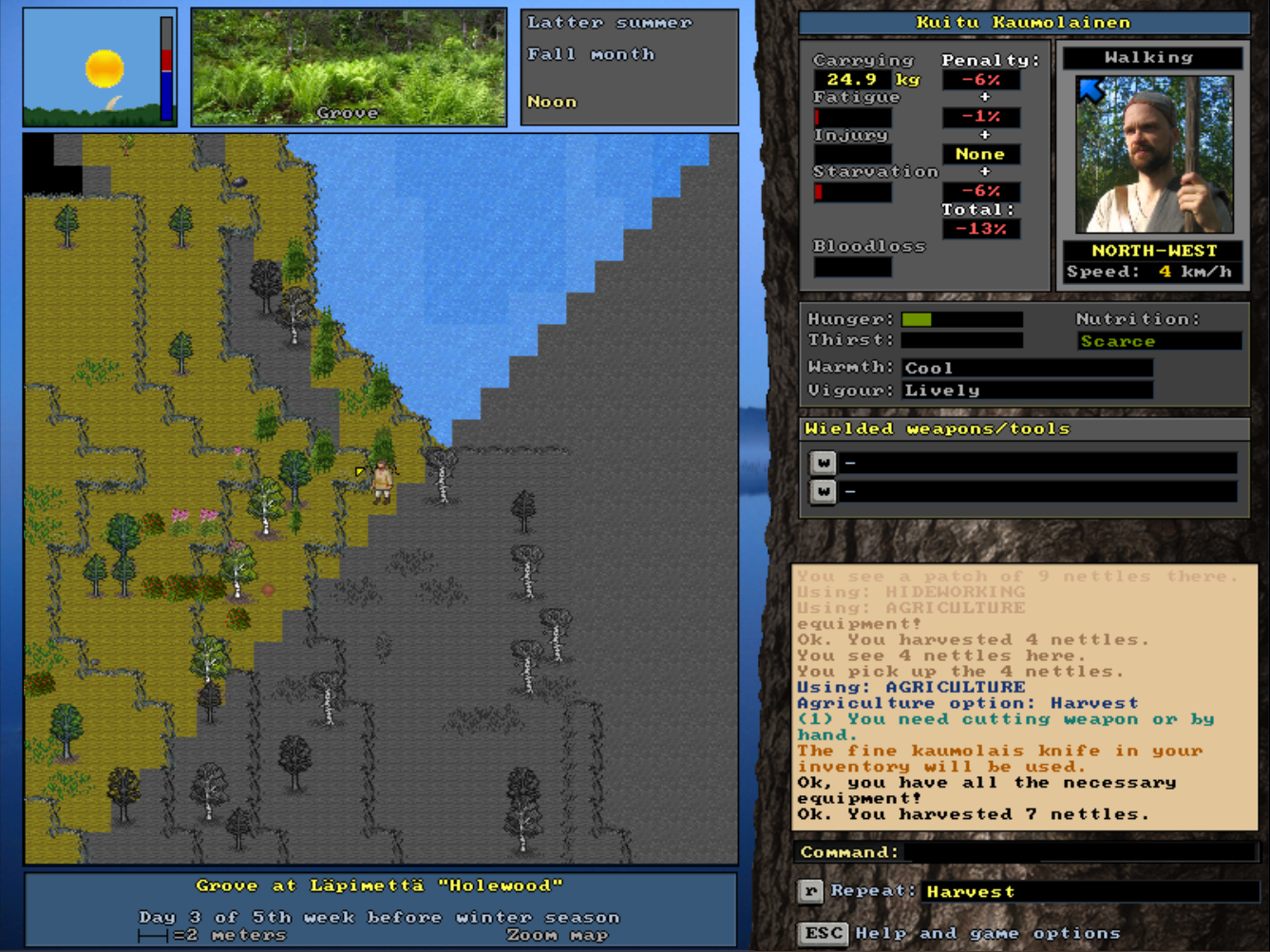 Kuitu harvests some nettles. Then he simply extracts the fibres by hand, and spins some nettle yarn. If he would like to produce a lot of yarn, this would be too slow to be practical, but now he's only after fishing rod line, Wooden hook, nettle yarn - and baits Kuitu finds a slender tree trunk, fashions a wooden hook out of a branch, and proceeds to assemble a fishing rod. Now we should mention that In the upcoming version usage of baits in fishing is also featured. Using baits is not necessary, but naturally highly recommended. Catching a fish every now and then without a bait is still possible, but for reliable rod fishing and decent catches baits are now quite essential. You can use pretty much every food item as a bait and portion of the selected item will be used during the fishing attempt. Pieces of raw meat and fish can be considered decent baits for predatory fish, but for example crumbs of bread may also work for some fish. You can also use a whole small fish, eg. roach or perch, in order to attract a bigger predatory fish. With this addition in effect the type of fish caught with rod fishing is now more dependant on the baits used. It's not likely that you'll catch a pike with an empty hook, but having a small roach as a bait might work. And that little roach might have been caught with quite moderate bait such as bread crumb, or even with some tasty vegetation. 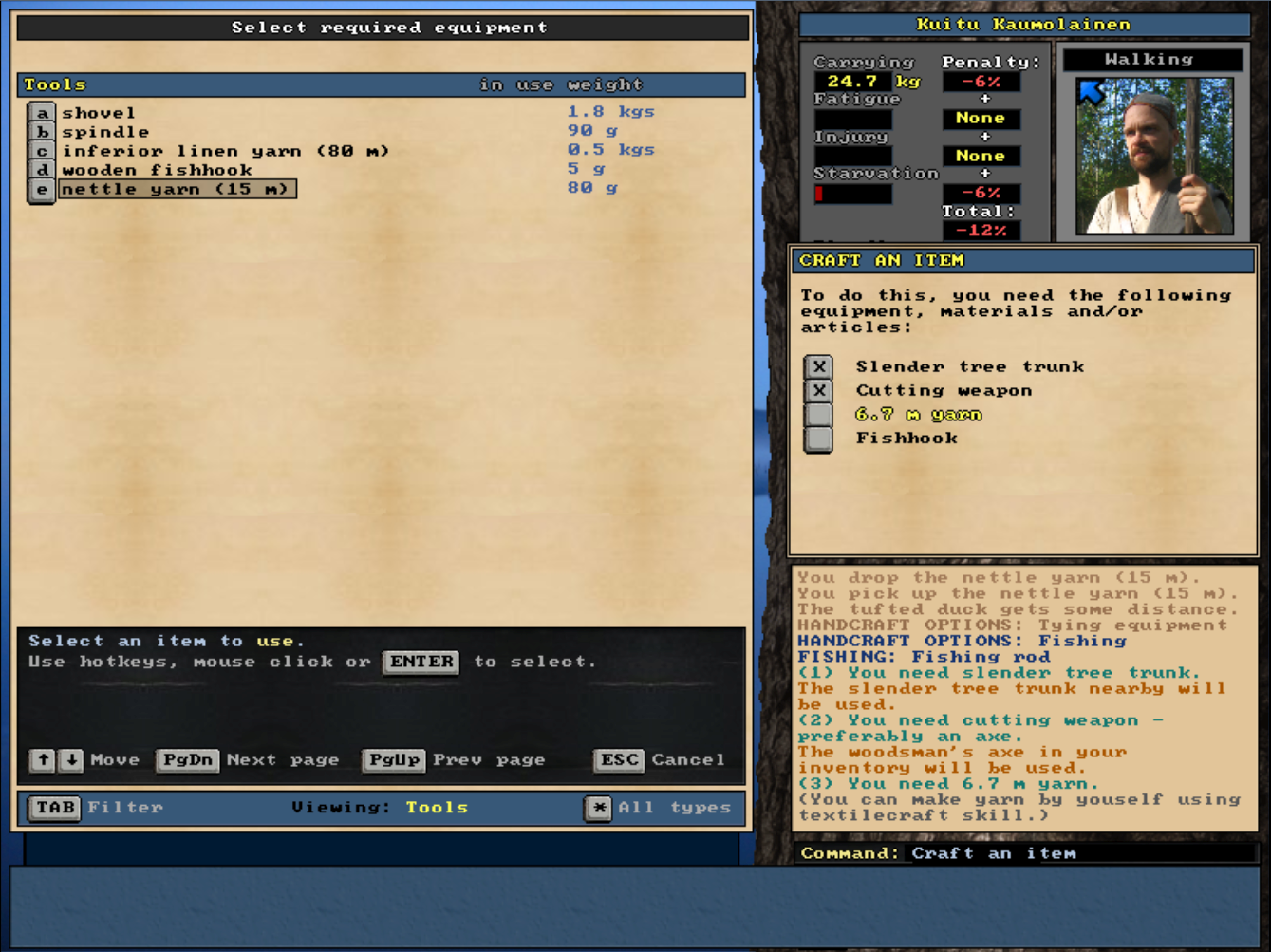 Kuitu makes his survival fishing rod, with a wooden hook and nettle yarn. The work with the several less laborous features continues but we're getting closer to release every day. It's always quite impossible to say when everything is completely wrapped up and working, but maybe - just maybe - we might have this version out in june. Cheers! For those who are more curious about the real life practises here's a short documentary in Finnish showing how the flax is processed. Having read the above I trust you will understand what is happening even without subtitles. The gear used differs slghtly from the more primitive method of the game, but the steps are the same; sow, harvest, ret, dry, extract, spin. https://www.youtube.com/watch?v=TNFD_CUlxZU May 11, 2021, 03:52:38 PM |
1 |


